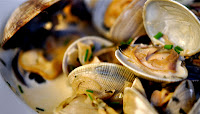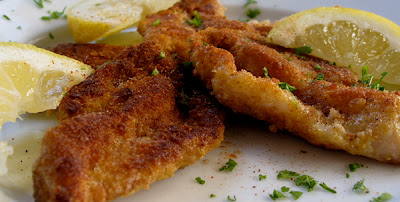 WHILE IN New York City recently I had a good ceviche of Atlantic razor clam (Ensis directus), which is smaller than the West Coast razor and quite narrow—like the straight razor of old. The ceviche came unmixed, with each ingredient—pickled peppers, onion, and so on—in colorful little piles. You were meant to slurp it all together in one bite like an oyster.
WHILE IN New York City recently I had a good ceviche of Atlantic razor clam (Ensis directus), which is smaller than the West Coast razor and quite narrow—like the straight razor of old. The ceviche came unmixed, with each ingredient—pickled peppers, onion, and so on—in colorful little piles. You were meant to slurp it all together in one bite like an oyster.
 Such a presentation is difficult with our big local razors (see top photo), since it’s more than a mouthful, but there’s no reason why we can’t use the shell as a serving dish, or even mix up the ingredients at table right in the shell.
Such a presentation is difficult with our big local razors (see top photo), since it’s more than a mouthful, but there’s no reason why we can’t use the shell as a serving dish, or even mix up the ingredients at table right in the shell.
Come to think of it, I never see West Coast razors as ceviche. So here goes…
Razor Clam Ceviche
This recipe is Japan Goes South of the Border. I use only the clam siphons as I prefer to save my diggers (the razor clam’s tender foot) for fried clams; besides, the siphon has a snappiness that’s perfect for ceviche. The amounts below are estimates; depends on the size of your clams and vegetables, and besides, with a little common sense it shouldn’t be too hard to figure out the right proportions. You can easily halve it for a smaller batch.
1 dozen razor clam siphons, cleaned and diced
2-3 cloves garlic, diced
1 small red pepper, diced
2-3 jalapeño peppers, diced
1/2 small red onion, diced
large handful cilantro, chopped
2 limes
aji-mirin
rice vinegar
tortillas, warmed
avocado, sliced
salt and pepper
1. Squeeze limes and mix juice with diced razor clams and garlic in a small non-reactive bowl. Season with salt and pepper plus a good splash of aji-mirin to taste and set aside. A general rule of thumb for ceviche is 1/2 cup citrus juice per pound of fish.
2. Cover diced red onion with rice vinegar and set aside. Chop together jalapeño pepper and cilantro if presenting ceviche unmixed.
3. Refrigerate at least an hour, preferably several hours.
4. Serve, mixed or unmixed, in razor clam shells or a small bowl with warm tortillas and avocado. Serves 4.
I have to say, this was easily one of the best ceviches I’ve ever had. Razor clams have a pleasing al dente texture. Steeped in the acidic lime juice, their flavor mellows, and aji-mirin adds a perfect finish. I’ll be making razor clam ceviche after every dig from now on..jpg&container=blogger&gadget=a&rewriteMime=image%2F*)

































